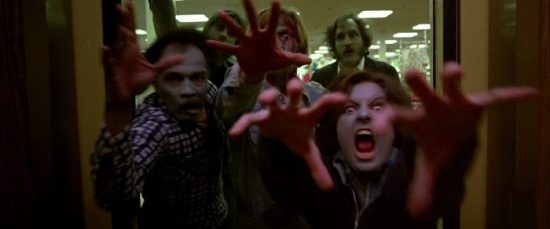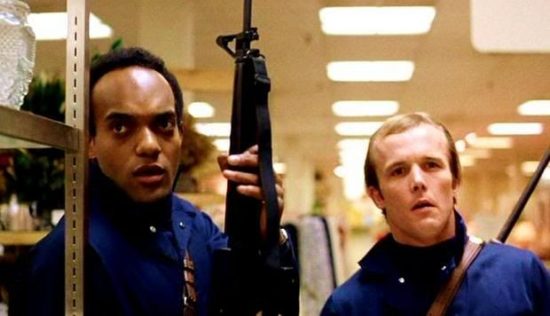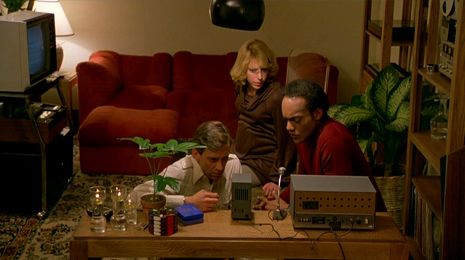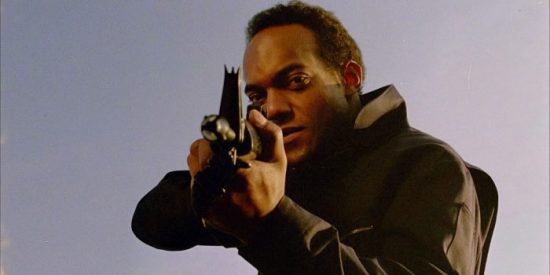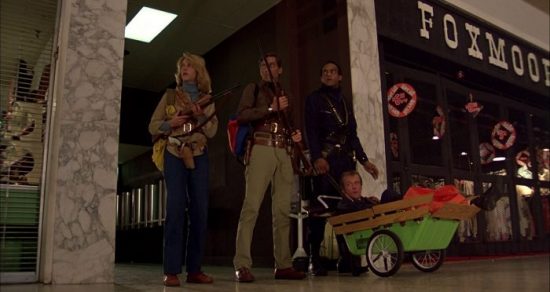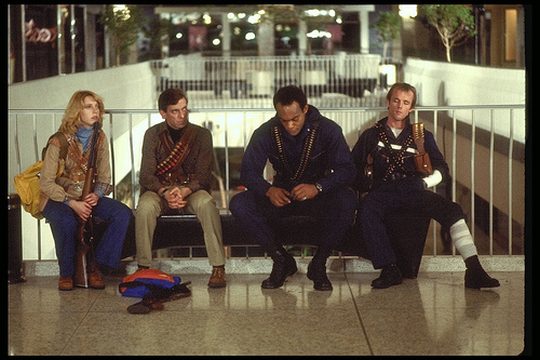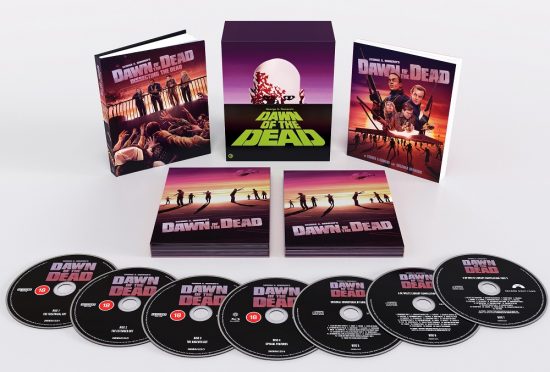Review: Dawn of the Dead Limited Edition Blu-Ray & 4K UHD
Directed by George A. Romero
Starring David Emge, Ken Foree, Scott Reiniger, Gaylen Ross
“When there’s no more room in Hell, the dead will walk the Earth”
I’ve loved Romero’s movies for as long as I can remember liking horror films. Dawn of the Dead, the second of his original trilogy (which later grew into a longer series), still occupies a special place in my Romero Pantheon though, and indeed retains a special place in my favourite horror films of all time, an excellent mix of horror, both from the gruesome deaths waiting everywhere by the hungry, walking dead, but also from the rapid disintegration of civilisation and the way so many humans respond to it, often as bad or worse than the zombie threat itself, leavened with some humour (few zombie horrors offer us the delights of the classic cream pie in the face fight!), and, of course, Romero’s social observations and satire.
I would imagine most collectors willing to spring for this pretty magnificent limited edition set from Second Sight will already be more than familiar with the film, and all of Romero’s works, but for those less familiar, a quick recap. Following the events of Romero’s seminal 1960s, genre-defining class Night of the Living Dead, the plague of the dead reanimating and stumbling slowly but remorselessly in pursuit of living flesh to chew has spread, civilisation is collapsing. We begin with two different scenes which introduce the main character – one set in a news studio, desperately trying to remain on the air and issue emergency information to citizens as communications break down and people give up and flee, one by one (including news helicopter pilot Stephen “Flyboy” Andrews – David Emge – and his partner Fran Parker, played by Gaylen Ross).
The other sees a SWAT squad of heavily armed police backed up my army units storming a down-town building, encountering a mix of gun-toting gang-bangers, desperate civilians and reanimated corpses. This is where we meet Roger (Scott Reiniger) and Peter (the iconic Ken Foree), dealing with criminals, zombies and fellow officers losing the plot and going gun-crazy as the situation falls apart. Even the police are giving up, the city is lost, most are choosing to flee while they can, and Roger tells Peter that his friend, Stephen, is a chopper pilot and he’s meeting him and Fran to escape later, inviting Peter to come with them.
On the run, we see encounters with other frightened groups of survivors and the ever-present menace of the creeping undead – nowhere is safe, even a rural airstrip where they stop to refuel, seemingly deserted. It is here we see the infamous “head slicing” as a zombie lurches towards Roger refuelling the chopper, unable to hear it over the engine noise, turning as he sees it stand up on a pile of boxes to get to him, only for the whirling blades to slice strips from the top of its skull (bloody but quite amazing special effects by the now-famous wizard Tom Savini, all practical effects, long before the dawn of CGI), a scene which manages to be stomach-turning and funny at the same time. A second scene in the small airport building, however, is far harder to take – Peter hears a noise, shoots through the door, only for it to open and two child zombies rush out at him, forcing him to shoot both in the head. They are undead zombies, but it’s still shooting a child, and Foree, to his credit, shows the toll this takes on Peter in a very quiet, understated but effective manner. The message here is clear: the world they knew, of rules and safety, is gone, they now have to commit acts they would never have dreamed of if they are to survive.
It is on the run that they spot a huge structure, which turns out to be an enormous indoor shopping mall – at the time a very new thing in the world. Originally planning to land and grab some supplies, they soon realise they could block the doorways with delivery trucks, clear the few zombies inside, and have a secure location to rest, which has everything they need from radios and TVs to listen for emergency broadcasts to clothes and every sort of food. The temporary stop soon becomes long-term, as what was a brief respite becomes a lack of drive to try and escape further north as originally planned – seduced by all the consumerist delights they make their new home comfortable with furniture from the stores, new clothes, an arsenal of weapons, drink and food. Fran, now several months pregnant, realises that they have essentially created their own comfortable prison, but it is one that will soon be shattered by the arrival of a marauding army of bikers who have been living on the road since the zombie apocalypse, pillaging where they can (and I will go no further for fear of spoilers for those who still haven’t seen this classic).
I will add, however, that re-visiting this film now, in the midst of our resurgent pandemic situation, added another layer for me as a viewer – the urge for our protagonists to hide inside and largely ignore the (unsafe) outside world, the sudden burst of pleasure after normal life is destroyed, in doing something as normal as shopping for stuff, half of which you don’t really need but just want the fun of shopping and buying and feeling normal. Oh yes, that took on a different meaning after all we’ve been going through this year. But then again that’s the mark of good storytelling, that it was written to speak about events of its own time but can still be re-interpreted decades on in a very different situation.
One of the aspects of Romero’s film-making I have always respected was his ability to take something different for each of his zombie films, something cultural and social from the era he made each in – Civil Rights being a huge influence in the original 1960s Night of the Living Dead, Cold War paranoia and apocalypse in the military bunker-set Day of the Dead, social media in Diary of the Dead and so on. Here in this 1970s offering with its vast, sprawling indoor mall of endless shops it is our lust for consumerism – a drive so strong that it attracts not only our fleeing heroes and distracts them with its baubles when they should be making plans to retreat somewhere safer, but also the zombies themselves. The undead have massed around this huge structure, struggling to get past the barricades our heroes put in place.
They are walking corpses, the items in the stores are of no use to them now (and in a dark mirror reflection we see that ultimately most of those shiny items we are so sure our life isn’t complete without are mostly of no use to Flyboy, Peter, Roger and Fran either, except as a dangerous distraction from the reality crashing in all around them). Flyboy opines that the reason so many are trying to get in is because they saw them enter and know they are still there. No, Peter argues, it isn’t them they are after, it is the building, the shops. They are us, or were us, and some dim spark in their decaying brains remembers this place as somewhere they liked to be, and it drives them on still in their undead existence, almost as strong an imperative as the urge for fresh flesh.
These limited edition 4K UHD and Blu-Ray sets are pretty damned impressive – we get three cuts of the film, from the original theatrical version, the slightly longer “Cannes” cut, and a third by the legendary Italian maestro of horror, Dario Argento, who wrote the story with Romero and was instrumental in getting international finance to allow the film to be made. There are CDs of the soundtrack by Argento regulars Goblin, newly commissioned artwork, a novelisation of the film and a hardback collection of essays, Dissecting the Dead.
Also among the extras, in addition to different commentaries on each of the various cuts of the film offered here (from Romero to Tom Savini to Ken Foree and others), there is an entire disc full of extras, which I have to say I really enjoyed working my way through. My favourite here was Zombies and Bikers, which talks to a whole slew of crew and cast, including many who gave their time to appear as zombie extras or the biker army, many of whom would be singled out by Romero for special close-ups and their own mini-arcs in the film. Memories of Monroeville sees Michael Gornick, Tom Savini, Tom Dubensky and Taso Stavrakis return to the original mall to explore some of the locations where they shot scenes and reminisce about the filming. Romero was friendly with people who ran the mall, and they allowed him to use it, but he could only shoot at night after the stores closed, which meant a long, arduous shooting schedule, having to wrap each morning as the automated, canned music and voice-over ads on the speakers would come on by themselves (this is echoed in the film where the same music and ads for the stores continues to play in the now empty – save for our four protagonists – mall, another echo of the emptiness of trying to fill our lives with consumerism).
A common thread in these two documentary extras, apart from a nice feeling of nostalgia as those involved look back on the work they did and how they could never at the time have anticipated that decades on it would remain this iconic, landmark film, is the sheer warmth in their memories. Despite the hours, working through the night for little money, many joining the shoot at night after their day jobs, everyone genuinely seems to have wonderful memories of the film, and most especially of the late Romero and what a charming and delightful director he was to work with. It reminded me of the time Romero visited the Edinburgh International Film Festival with Diary of the Dead – decent enough film, not his best though, but the reception the man himself got from the audience was amazing, it was clear how much love there was in the room for this man, he was “Uncle George” to most of us, and I could see that in these recollections in the extras.
It was also very clear from these documentaries, and a previously unseen interview with Romero, that this film, a film that now has a secure place in cinema history, only exists because so many people like those featured in the extras here were happy to put in the time, working for a token fee, to help make Romero’s script turned into reality, while others helped with letting them use locations they could never have afforded to rent or recreate on a sound-stage. With many it came down to a combination of love for his Night of the Living Dead and also a lovely community support aspect – a sort of wow, we’re making a feature film right here in Pittsburgh, not Hollywood, yes, I want to help you make that happen. Again it is such a warm wave of enthusiasm and mutual support for fellow creators which is inspiring to see. All in all this is a terrific collector’s edition, with well-restored cuts of the film in different edits and jam-packed with extras, giving this iconic horror the respect it richly deserves.
The limited-edition set Second Sight has put together is a cine-collector’s dream – three different cuts of the film, a whole disc full of extras, newly commissioned artwork, audio CDs (including Goblin’s soundtrack), novelisation and a hardback book, Dissecting the Dead. Dawn of the Dead, and is released in a special Limited Edition 4K UHD and Blu-Ray by Second Sight on November 16th.

